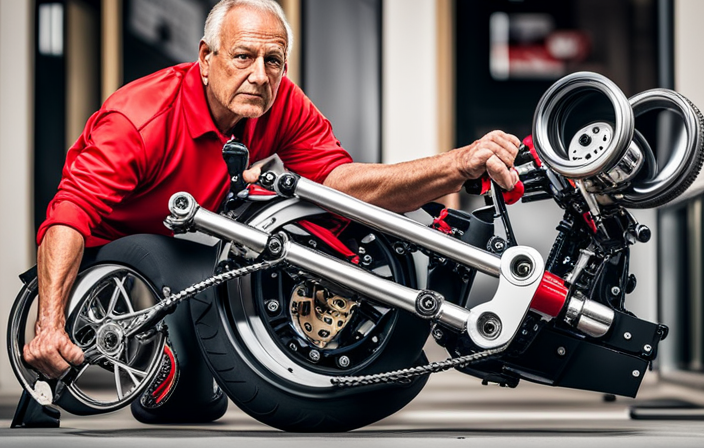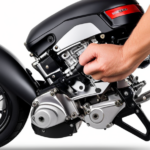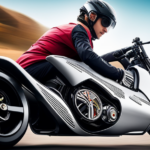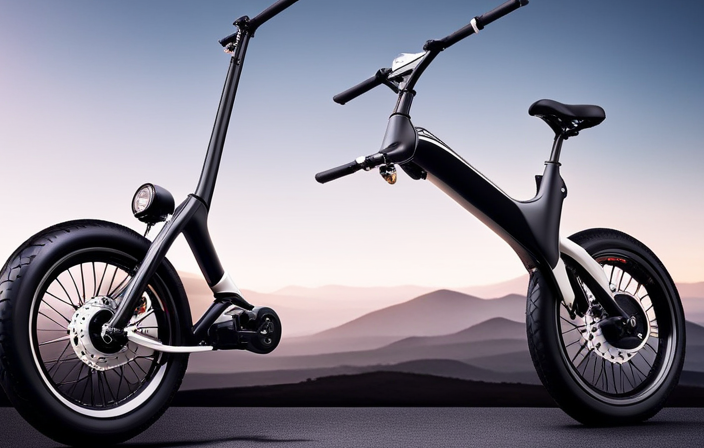Are you ready to take your pocket bike to the next level of simplicity and efficiency? Look no further!
In this step-by-step guide, we will show you how to remove the electric start from your pocket bike. By doing so, you will streamline your bike’s functionality and eliminate any unnecessary components.
With the right tools and a little bit of know-how, you’ll be well on your way to enjoying a more streamlined and customized pocket bike experience.
So, let’s roll up our sleeves and get started!
Key Takeaways
- Removing the electric start from a pocket bike eliminates the need for a battery and reduces the overall weight of the bike.
- Manual kick start provides quicker and more responsive starts, enhancing the riding experience.
- Regular maintenance and lubrication of the kick start lever are essential for smooth operation.
- Promptly address any issues with the kick start system, such as difficulty in starting or signs of wear or damage.
Gather the Necessary Tools and Equipment
Before you can remove the electric start from your pocket bike, you’ll need to gather the necessary tools and equipment. To start, you’ll need a socket set with various sizes of sockets, a wrench set, and a screwdriver set with both Phillips and flathead options. Additionally, you’ll need a spark plug wrench and a multimeter to troubleshoot common electric start issues.
Once you have all the tools, it’s important to read the pocket bike’s manual to understand the specific steps for installing a manual ignition. This will help ensure that you don’t miss any crucial details.
By having all the necessary tools and equipment on hand, you’ll be prepared to tackle the task of removing the electric start from your pocket bike. Now, let’s move on to the next step: disconnecting the battery.
Disconnect the Battery
First, you’ll need to disconnect the battery on your pocket bike. This is an essential step in the process of removing the electric start.
To do this, follow these steps:
-
Locate the battery compartment on your pocket bike. It is usually located under the seat or in the front fairing.
-
Use a wrench or a screwdriver to remove the bolts or screws that secure the battery cover.
-
Carefully lift the battery cover to reveal the battery.
-
Disconnect the negative (-) terminal first by loosening the nut with a wrench and then removing the cable from the terminal.
-
Repeat the same process for the positive (+) terminal.
By disconnecting the battery, you ensure that there is no power running through the electric start system. This will allow you to safely proceed with removing the electric start button in the next section.
Remove the Electric Start Button
Next, you’ll want to disconnect the wires leading to the start button. To do this, follow the steps outlined in the table below:
| Step | Action |
|---|---|
| 1 | Locate the start button wires. |
| 2 | Use a pair of wire cutters to cut the wires. |
| 3 | Make sure to leave enough length for future reconnection if needed. |
By removing the electric start button, you can troubleshoot any electric start malfunction more effectively. This step is crucial in the process of removing the electric start system from your pocket bike. Once the wires are disconnected, you can move on to the next section and locate the electric start motor. This will allow you to continue the process of removing the electric start and transition smoothly to the subsequent steps.
Locate the Electric Start Motor
To continue with the process, you’ll need to find the motor responsible for the electric start. The electric start motor is usually located near the engine, typically on the side or underneath.
Start by removing any coverings or panels that may be hiding the motor. The motor will have wires connected to it, which are part of the wiring harness. Take note of how the wires are connected before proceeding.
If you plan on installing a kick start, you will need to disconnect the wiring harness from the electric start motor. This step is crucial to ensure that the electric start system is completely removed and the kick start can be properly installed.
Disconnect the Wiring Harness
After locating the electric start motor, it is important to disconnect the wiring harness to ensure proper removal. To do this, follow these steps:
-
Begin by identifying the red and black wires connected to the motor. These wires are responsible for powering the electric start.
-
Carefully disconnect the battery cables from the battery. This will ensure that no power is flowing to the wiring harness.
-
Next, locate the connectors or clips that attach the wiring harness to the electric start motor. Gently squeeze or press these connectors to release them from the motor.
-
Once the connectors are detached, carefully remove the wiring harness from the electric start motor. Be cautious not to damage any of the wires in the process.
By following these steps, you will be able to disconnect the wiring harness from the electric start motor. This will allow you to relocate the battery or troubleshoot any wiring issues.
Now, let’s move on to the next section about removing the electric start motor.
Remove the Electric Start Motor
Once the wiring harness is disconnected, the electric start motor can be easily removed.
Begin by locating the motor, which is typically located on the side of the engine. Use a socket wrench to remove the bolts securing the motor to the engine block.
Once the bolts are removed, carefully disconnect the wires attached to the motor. Be sure to label the wires or take a photo for reference during reassembly.
With the wires disconnected, the motor can now be lifted off the engine block. Set the electric start motor aside, as it will no longer be needed.
At this point, you can proceed to install the manual kick start, which will replace the electric start function. Dispose of the electric start components properly.
Now, let’s move on to the next step of removing the electric start gear.
Remove the Electric Start Gear
Now, you can easily take off the gear responsible for the electric start. To do this, follow the steps below:
| Step | Instructions |
|---|---|
| 1 | Locate the electric start gear, which is usually located on the side of the engine. |
| 2 | Use a socket wrench to remove the bolts that secure the gear in place. |
| 3 | Once the bolts are removed, carefully lift the gear off the engine. Be cautious not to damage any surrounding components. |
By removing the electric start gear, you are now one step closer to installing a manual ignition system or troubleshooting any issues with the electric start. In the next section, we will discuss how to remove the electric start clutch without any hassle.
Remove the Electric Start Clutch
To proceed with removing the electric start clutch, you’ll need to follow these steps:
-
Start by locating the clutch cover on the engine. Use a wrench to remove the bolts securing the cover in place.
-
Once the cover is removed, you’ll see the clutch assembly. Use a socket wrench to loosen and remove the bolts holding the clutch in place.
-
Carefully remove the clutch from the engine, making sure not to damage any surrounding components.
-
Inspect the clutch for any signs of wear or damage. If necessary, replace the clutch with a new one.
Now that you have successfully removed the electric start clutch, you can proceed to the next section and learn how to install the manual kick start. It is important to follow these steps precisely to ensure proper functionality of your pocket bike.
Install the Manual Kick Start
After successfully removing the electric start clutch, proceed to the next section to learn how to install the manual kick start.
The installation process for the manual kick start is relatively straightforward, but it requires attention to detail. Start by aligning the kick start lever with the kick start shaft and secure it in place using the provided bolts. Make sure to tighten them properly to prevent any loosening during operation.
Once the kick start lever is securely installed, test it by gently kicking it down to ensure smooth movement. Troubleshooting common issues during the installation process may include checking for any misalignment or loose connections. If any issues arise, double-check the installation steps and consult the pocket bike’s manual for further guidance.
Next, we will discuss how to reconnect the wiring harness.
Reconnect the Wiring Harness
First, you need to ensure that the wiring harness is properly reconnected. This is crucial for the electric start removal process on your pocket bike.
Start by inspecting the wiring harness and identifying the corresponding connectors. Carefully align the connectors and push them together until you hear a click, indicating a secure connection. Take extra caution to avoid any loose or disconnected wires, as this can lead to electrical issues later on.
Once the wiring harness is reconnected, you can proceed to troubleshoot any potential issues. Test the electrical components, such as the lights and ignition system, to ensure they are functioning properly. This will help you identify and address any wiring-related problems before moving on to the next step of testing the manual kick start.
Test the Manual Kick Start
Once you have ensured that the wiring harness is properly reconnected, you can now test the manual kick start on your bike. Here are four steps to help you test the kick start mechanism and troubleshoot any issues:
-
Position the bike on a flat and stable surface. Make sure the transmission is in neutral and the engine kill switch is in the ‘on’ position.
-
Stand on the left side of the bike and firmly grip the handlebars. Use your right foot to push down on the kick start lever with a swift and forceful motion. This should engage the engine and attempt to start it.
-
If the engine does not start, try adjusting the position of the choke lever. Sometimes, a partial or full choke may be needed for a cold engine or in certain weather conditions.
-
If the kick start still doesn’t work, check for any loose or damaged components in the kick start system such as the kick start lever, spring, or shaft. Repair or replace any faulty parts accordingly.
Now that you have tested the kick start mechanism, you can move on to securing and fastening all components to complete the removal of the electric start.
Secure and Fasten all Components
To finish the removal of the electric start, make sure to securely fasten all components in place. This will ensure a secure installation and prevent any issues during operation. Below is a table outlining the different components and their corresponding fastening methods:
| Component | Fastening Method |
|---|---|
| Battery | Tighten the screws |
| Starter motor | Use lock washers |
| Wiring harness | Secure with zip ties |
| Ignition switch | Bolt it in place |
| Kick start lever | Ensure it is tightened securely |
By following these maintenance tips and properly securing all components, you will have a reliable pocket bike without the electric start. Now, you can move on to the next section and clean and organize your work area for the remaining steps.
Clean and Organize your Work Area
Make sure you clean up and arrange your workspace for the upcoming tasks. This is an essential step to ensure a smooth and efficient removal of the electric start from your pocket bike.
Start by removing any clutter or unnecessary items from your work area, creating a clean and organized space. Use cleaning tips such as wiping down surfaces with a damp cloth and sweeping the floor to eliminate any dust or debris that could interfere with your work.
Additionally, setting up a work schedule can help you stay focused and on track. Allocate specific time slots for each task, ensuring that you have enough time to complete them without rushing.
Once your workspace is clean and organized, you can proceed to dispose of the electric start components properly.
Transitioning into the subsequent section about ‘dispose of the electric start components properly,’ you can now move on to the next step in the process.
Dispose of the Electric Start Components Properly
After cleaning and organizing your workspace, it’s important to properly dispose of the components from the electric start.
Proper disposal methods are crucial to prevent potential hazards and environmental damage.
When removing the electric start, make sure to disconnect the battery and remove any wiring or cables.
These components can contain toxic substances and should not be thrown in regular trash.
Instead, check with your local recycling center or electronic waste collection facility for proper disposal options.
Some areas may have specific guidelines for disposing of electronic components, so it’s essential to follow those instructions carefully.
By disposing of the electric start components responsibly, you are not only protecting the environment but also ensuring the safety of others.
Now, with the electric start removed, you can move on to enjoying your newly modified pocket bike.
Enjoy Your Newly Modified Pocket Bike
Now that you have successfully disposed of the electric start components, it’s time to enjoy your newly modified pocket bike with a manual kick start system.
Switching to manual kick start offers several advantages over electric start. Firstly, it eliminates the need for a battery, reducing the overall weight of your pocket bike. Secondly, it provides a more direct and instantaneous power transfer, resulting in quicker and more responsive starts.
To ensure the smooth operation of your manual kick start system, it’s important to perform regular maintenance. Keep the kick start lever well lubricated and check for any signs of wear or damage.
Additionally, familiarize yourself with troubleshooting techniques in case of any issues, such as improper engagement or difficulty in starting.
By following these tips, you’ll be able to enjoy the reliability and simplicity of a manual kick start system on your pocket bike.
Frequently Asked Questions
How do I gather the necessary tools and equipment for removing the electric start from my pocket bike?
To gather the necessary tools and equipment for removing the electric start from your pocket bike, you will need a set of wrenches, a socket set, pliers, and a screwdriver. Additionally, you may require a multimeter to check electrical connections.
Ensure you have a workbench or a stable surface to place your pocket bike on during the process. Having a container to store small components and a rag to clean any dirt or grease is also recommended.
What precautions should I take while disconnecting the battery?
When it comes to disconnecting the battery, there are several important safety measures and precautions that you need to keep in mind.
First and foremost, make sure to wear protective gloves and goggles to avoid any contact with corrosive materials or sparks.
Before starting, ensure that the ignition switch is turned off and the key is removed.
Then, carefully disconnect the negative terminal first, followed by the positive terminal, to prevent any electrical accidents.
How do I remove the electric start button from my pocket bike?
To disconnect the electric start button from your pocket bike, you will need to follow a few precise steps.
First, locate the wiring harness connected to the button.
Next, carefully disconnect the wires by gently releasing the connectors.
Once the wires are detached, remove the button from its mount by unscrewing the bolts or clips securing it.
Take care not to damage any surrounding components.
Where can I locate the electric start motor in my pocket bike?
In the intricate mechanics of your pocket bike, the electric start motor hides, waiting to be discovered.
To locate this essential component, delve into the depths of your pocket bike’s engine. Once you have unraveled the intricate maze of wires and connections, you will find the electric start motor nestled among them.
Troubleshooting common issues with pocket bike electric starts will equip you with the knowledge needed to masterfully modify your pocket bike engine.
How do I properly dispose of the electric start components after removing them from my pocket bike?
Proper disposal of the electric start components from your pocket bike is crucial to minimize the environmental impact.
To ensure proper disposal, you should first disconnect the battery and remove any fuel or oil residue.
Next, consult your local waste management guidelines to determine the appropriate method of disposal.
It’s important to dispose of these components in an environmentally responsible manner to prevent any harmful substances from contaminating the soil or water sources.
Conclusion
Congratulations on successfully removing the electric start from your pocket bike! By following these steps, you have transformed your ride into a more traditional and mechanically engaging experience.
This modification not only enhances the bike’s performance but also adds a touch of nostalgia and authenticity.
Take pride in your accomplishment and relish in the raw power and control you now possess.
Remember to always ride responsibly and enjoy the exhilarating ride on your newly modified pocket bike!















